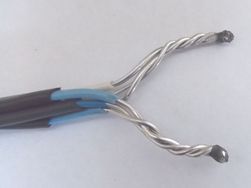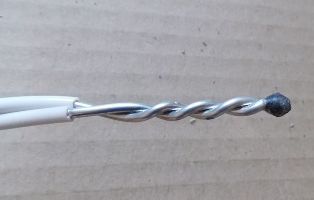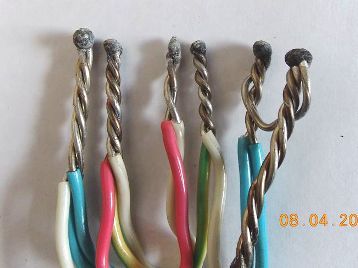Categories: Electrician Secrets, Electric installation work
Number of views: 37764
Comments on the article: 4
Connection by welding aluminum wires
 "Rules for the installation of electrical installations" allow only 3 ways to connect conductors: soldering, welding and clamping in terminals. This also applies to pre-twisted wires in junction boxes. The best electrical characteristics, reliability and durability are uniquely welding. In addition, with a large number of compounds, this method is also the fastest and cheapest. With copper wires, the issue is resolved and closed.
"Rules for the installation of electrical installations" allow only 3 ways to connect conductors: soldering, welding and clamping in terminals. This also applies to pre-twisted wires in junction boxes. The best electrical characteristics, reliability and durability are uniquely welding. In addition, with a large number of compounds, this method is also the fastest and cheapest. With copper wires, the issue is resolved and closed.
However, despite the requirements of the 7th edition of the PUE on the termination of the use of aluminum wires for electrical wiring (with a cross section of less than 16 sq. Mm.), They are still used and quite widely. For example, during the repair (without complete replacement) of the old aluminum wiring. Combining copper with aluminum is even worse than leaving aluminum.
Thus, the question of welding aluminum is becoming very urgent, especially since its physical and chemical properties make other joining methods more difficult.
The most unpleasant of these properties is the rapid oxidation of aluminum in air with the formation of a very strong oxide film. It has such a large electrical resistance that in low-voltage devices (microchips, electrolytic capacitors, etc.) it is even used as a dielectric.
In spring and screw connections (due to warping of the base), the oxide film is destroyed at the time of drawing, but the contact resistance of contact with such inclusions is still increased, which leads to its heating with all the ensuing consequences. Oxides soldering and welding interfere even more.
To combat this film during soldering, mechanical cleaning during tinning can be used for a long and difficult time, especially at a height, and when welding, oscillating devices operating in an inert gas atmosphere and piercing an oxide film with high-voltage electric pulses are very bulky and expensive.
A universal method for both types of compounds is the chemical dissolution of the film by special fluxes. Finding the optimal composition of the flux is not an easy task: it must efficiently dissolve alumina, minimally reacting with pure metal (despite the fact that the strength, melting point and chemical resistance of the oxide are much higher), not emit any harmful compounds that cause corrosion of surrounding objects or too toxic to humans, and so on.
Today, there is a very good, acceptable for work at a height, flux composition selected from several options, which was tested when testing the technology of welding aluminum strands using twist welding machine TC 700-2.

The flux for aluminum welding is a white powder, which is enough to dissolve with water to the state of sour cream and apply by immersion or brush on the end of 4-6 mm of prepared twist.
Welding is performed similarly to copper wires - in about 1-2 seconds, supplied from below, to the end of the twist by a carbon electrode. For high-quality welding, the electrode surface should be periodically cleaned of sticky scale and slag. The flux dissolves the oxide film of aluminum, eliminates the access of oxygen in the process of droplet formation and prevents the electrode from sticking.
But it is important to first practice on pre-prepared twists before proceeding with welding at critical sites. After welding, it is advisable to rinse the ends of the welded strands with any solvent and cover with any quick-drying varnish with their subsequent isolation.

An important point in the welding of aluminum twists of small sections is the rather low arc voltage.The lower melting temperature of aluminum than copper leads to its spraying at the place of formation of the necessary drop. Therefore, devices with a voltage of no more than 20V on the electrodes should be used, for example, a TS 700-2 transformer specially designed for welding in junction boxes and cabinets.

In conclusion (so that someone does not have erroneous impressions), we summarize as follows: nothing revolutionary has been invented. Old proven way. It’s just that now there is a more efficient flux and a more convenient and inexpensive specialized welding machine, suitable for welding coils of different materials, which makes welding of coils available even to beginners-electricians, after an appropriate training.
Alexey Begeneev
Devices for welding copper and aluminum twisting Тс 700-2, are used in the electrical field.
Twist welding of aluminum wires with flux:
See also at bgv.electricianexp.com
:
